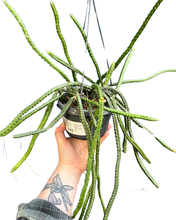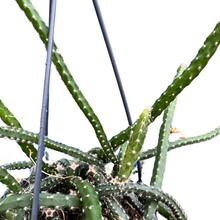Selenicereus grandiflorus is part of the Cactaceae family and is native to Mexico (Tamaulipas to Tabasco) to Guatemala, N. Caribbean. It is epiphytic or lithophytic in growth and will use adventitious roots to climb on surrounding trees in order to seek more light and to support its weight; they can grow several metres in length. Under the right conditions S.grandiflorus will produce large sweet smelling flowers, which open at night.
Selenicereus meaning 'Moon Cereus', refers to the night bloom and the specific epiphet 'grandiflorus' comes from the Latin for 'large flowered'.
Pot: 14cm diameter.
Foliage: Approximately 40cm in length.
Light: Bright indirect light, meaning the plant sees the sun for 0-4 hours per day - this could be through trees or a translucent curtain, it’s important for the plant to see the sky in order to thrive. In its natural environment this plant would receive dappled light.
Water: Allow the majority of the mix to dry out. Before watering, ensure the substrate isn’t compacted, if it is, aerate it with a few pokes of a skewer or blunt stick, pour water slowly over the top and allow the water to pass through the drainage holes. Water sparingly in winter.
Potting mix: A well draining mix composed of coco coir, perlite or vermiculite, orchid bark and worm castings; you could also add some horticultural charcoal to this epiphytic mix. This plant requires developing a vigorous root system in order to flower so shouldn’t be repotted for a few years.
Fertilising: Feed your plant with a cactus fertiliser every other watering during the growing season. You can dilute fertiliser to half the recommended amount but never add more.
Temperature: 18-26°C, in the growing season. In winter keep Selenicereus in a cooler spot, between 10-15˚C in order to encourage flowering.
Humidity: Selenicereus grandiflorus would prefer higher humidity but do well to adapt to average home humidity. You can increase humidity by placing the plant on a watered pebble tray or using a humidifier.
Selenicereus grandiflorus are non-toxic.



